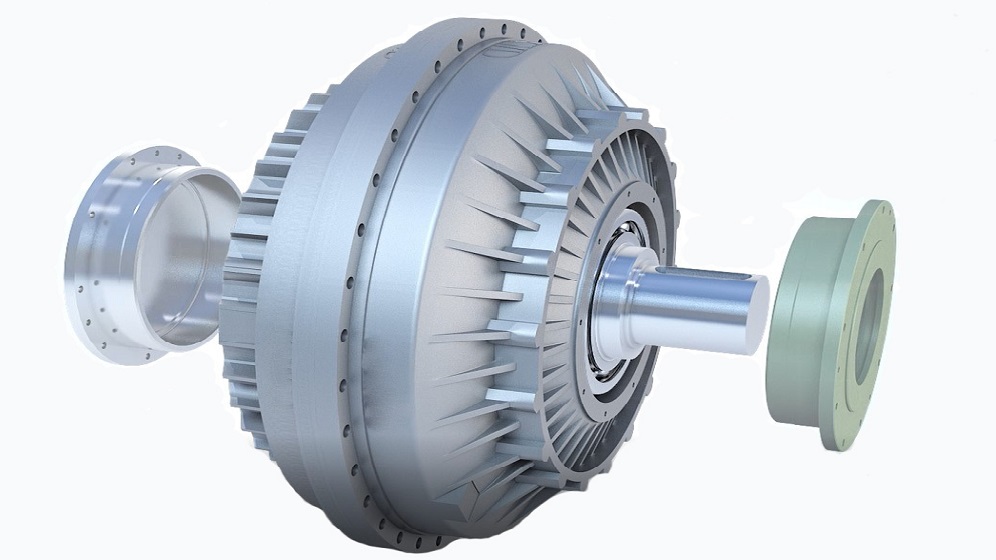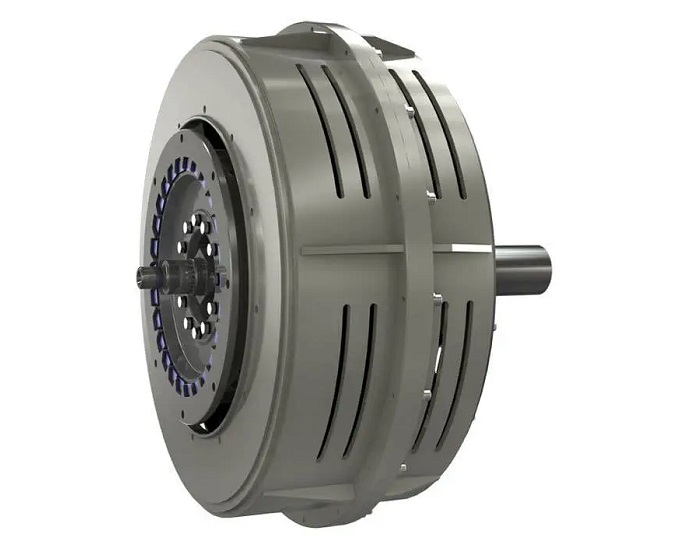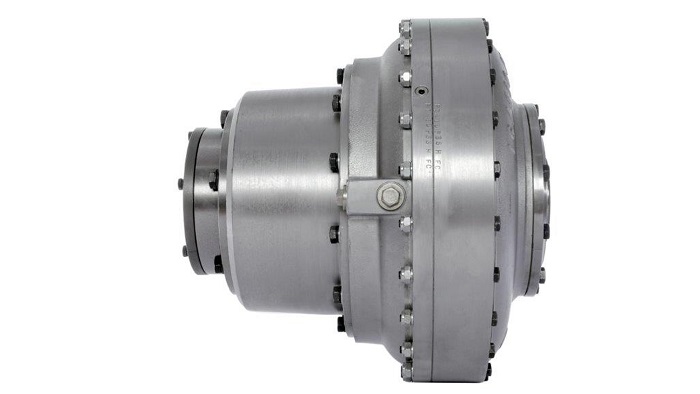Welcome to Linquip Blog. Today and in this article, we are going to deal with the question “What is a Fluid Coupling?”. The information in this article gives a significant collection of technical data about working principles, operation, and usages of fluid couplings.
Stay with us until the end to find the answer to your question on this topic.
An Introduction to the Fluid Coupling and Its Parts
The fluid coupling also known as the hydraulic coupling is a hydrodynamic device that is used to transfer rotational power from one shaft to another by the use of transmission fluid comprised of three main elements:
- Driving impeller mounted on the input shaft.
- Driven impeller mounted on the output shaft.
- Cover, flanged to the output impeller, with an oil-tight seal.
The Working Principle of Fluid Coupling
The working principle of fluid can be easily explained by taking two fans in which one is connected to the power supply and other is not. When the power switch is on, the air from the first fan starts to blow toward the second fan (which is not connected to the power source). Initially, when the first fan is blowing at a lower speed, it is not able to drive the second fan. But as the speed of the powered fan increases, the speed of air striking the blades of the second fan also increases and it starts to rotate.
Fluid couplings or hydraulic couplings work on the hydrodynamic principle. In drives consisting of fluid couplings, there is no mechanical contact between the driver and the driven machine, and power is transmitted by means of a fluid. Due to the mechanical separation between the driver and the driven machine, a fluid coupling achieves two separate values of acceleration in the drive, the fast value of acceleration for the driver and simultaneously the slow value of acceleration for the driven machine.
Fluid couplings are often used to drive large inertia machines in combination with squirrel cage motors. They permit a load-free acceleration of the motor and consequently with increasing oil fill, provide a soft/gentle quasi steady state start-up of the machine.
Fluid couplings are used in drives for conveyor systems such as belt conveyors, bucket elevators, and chain conveyors. The smooth application of fluid coupling torque provides a smooth start-up of the belt conveyor to protect the belt from damaging stresses.
In heavy industry, they are used for applications such as crushers, roller presses, mixers, large ventilators, boiler feed pumps, large compressors, centrifuges, etc.
How to Use a Fluid Coupling
So far, you are familiar with hydraulic couplings and how they work with a clear example. In this section, we want to acquaint you with the uses of this device in various situations.
-
Industrial Applications
Fluid couplings are used in many industrial applications involving rotational power, especially in machine drives that involve high-inertia begins or continuous cyclic loading.
-
Rail transportation
Fluid couplings are found in some Diesel locomotives as part of the power transmitting system. Self-Changing Gears made semi-automated transmissions for many counties’ Railways.
-
Automatic Transmissions
Fluid couplings were used in a variety of early semi-automatic transmissions and automated transmissions. In motor vehicle applications, the pump is typically connected to the flywheel of the engine, the coupling’s enclosure may be the area of the flywheel appropriate, therefore, is switched by the engine’s crankshaft. The turbine is linked to the insight shaft of the transmission. While the transmitting is in gear, as engine quickness increases torque is normally transferred from the engine to the insight shaft by the motion of the fluid, propelling the automobile. In this respect, the behavior of the fluid coupling highly resembles that of a mechanical clutch driving a manual transmitting.
Fluid flywheels, as distinctive from torque converters, are most widely known for their use in Daimler vehicles in conjunction with a Wilson pre-selector gearbox. Daimler utilized these throughout their selection of luxury cars, until switching to automated gearboxes with the 1958 Majestic. Daimler and Alvis had been both also known for his or her military vehicles and armored vehicles, a few of which also utilized the combination of pre-selector gearbox and fluid flywheel.
Aviation
The many prominent utilization of fluid couplings in aeronautical applications was in the DB 601, DB 603, and DB 605 motors where it was used as a barometrically controlled hydraulic clutch for the centrifugal compressor and the Wright turbo-substance reciprocating engine, where three power recovery turbines extracted around 20 percent of the energy or about 500 horsepower (370 kW) from the engine’s exhaust gases and then, using three fluid couplings and gearing, converted low-torque high-acceleration turbine rotation to low-speed, high-torque result to operate a propeller.
Advantages of Fluid Couplings
Now that you are familiar with the applications of this fluid coupling, let’s take a brief look at its advantages:
- Wear-free power transmission due to the absence of mechanical connection between the input and output elements.
- No-load start-up of motor irrespective of machine load.
- Sequential starting of multiple motors to reduce the aggregate value of current drawn.
- Smooth and controlled acceleration of large inertia-driven machines by a simple squirrel cage induction motor.
- Motor selection to operating duty/load rather than starting loads resulting in lowering capital cost.
- Overload protection for motor and driven machine by limiting maximum torque to a predetermined safe value.
- Simple control of torque by changing the fill level (amount of operating fluid).
- Automatic unloading of prime mover in case of sustained overload due to response (blowing-off) of fusible safety plug.
- Effective dampening of shocks, load fluctuations, and torsional vibrations.
- Step less speed variation in scoop tube type fluid couplings.
- High efficiency due to low slip at rated duty
Conclusion
The present article was an attempt to deal with the question “What Is a Fluid Coupling?” and deliver all the essential information about how it works and where it is used. The fluid coupling also known as the hydraulic coupling is a hydrodynamic device that is used to transfer rotational power from one shaft to another by the use of transmission fluid.
If you have any experience using Fluid Couplings, we will be very glad to have your opinions about their performance in the comments on our website Linquip. Moreover, if you have any questions about this topic, you can sign up on our website and wait for our experts to answer your questions. Hope you enjoyed reading this article.
Buy Equipment or Ask for a Service
By using Linquip RFQ Service, you can expect to receive quotations from various suppliers across multiple industries and regions.
Click Here to Request a Quotation From Suppliers and Service Providers
Read More on Linquip
- What Is a jaw Coupling? With the Focus on the Working Principle, Size & Dimension
- The Practical Guide To Types of Coupling in 2021
- What is Grid Coupling? Essential Details You Need To Know
- A Cheat Sheet For The Types of Pump Couplings
- Advanced Guide: Types of Rigid Couplings
- The Quick Guide To The Types of PVC Couplings
- Types of Shaft Couplings: A Simple Guide to The Types
- The Complete Library of Types of Flexible Coupling
- Types of Gear Coupling: a Basic Yet Crucial Description of the Types
- Flange Coupling Adaptor: Working Principle and Applications
- What Is a Sleeve Coupling? Everything You Need to Know
- What is Disc Coupling: A Complete Guide







This looked like a good article until I realised that the English is so bad I can’t understand or believe what it says.